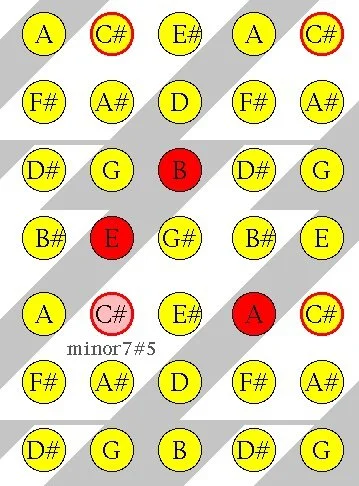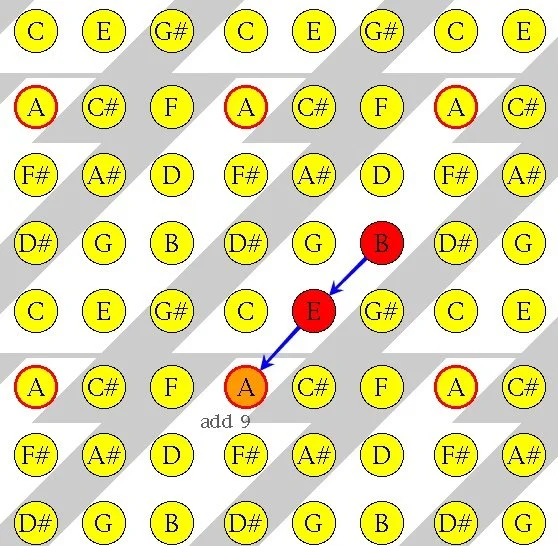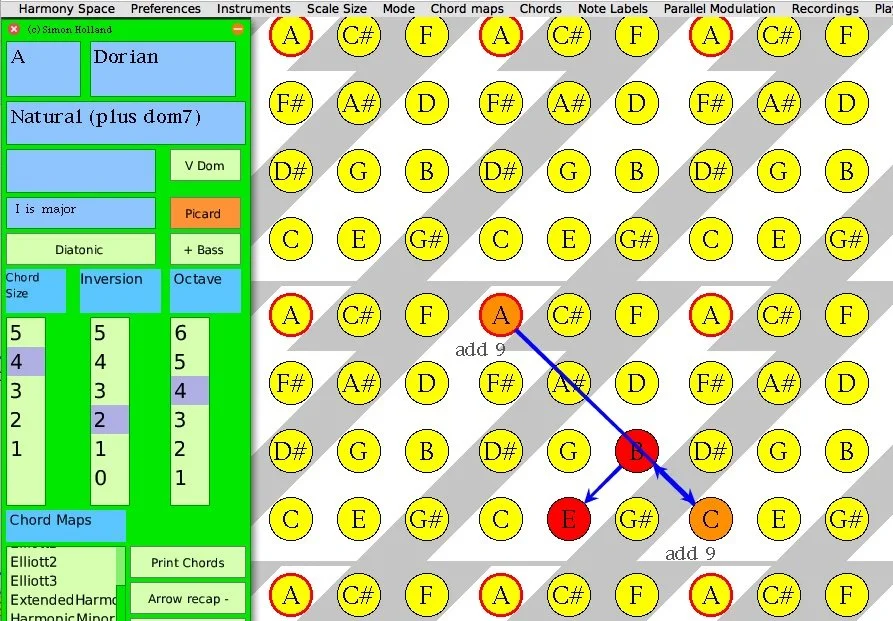My Forbidden Lover - Chic
https://www.youtube.com/watch?v=vxLKKz7Mqgs
Why is interesting about this chord sequence?
Many chord sequences given for this song found on the internet fail to capture the voicing. However, co-composer Nile Rodgers stresses in his autobiography that he always pays great attention to voicing and voice leading. So we should take that into account. A reasonably accurate description of the voicing seems to be:
C#m7 #5 C/D Bm7 E m7
Looking at the first chord in harmony space, there is something interesting. This C# chord seems to sound like home - the sequence keeps returning to I t- but the key can hardly be C# major, as three out of the four notes in that chord are not even in that key A.
Shifting the harmony space key window around experimentally to look for other modes of C# that could fit this chord, we discover that if we wanted to treat C# as the root of this chord, it would fit as a simple variant of I (i.e the home chord) in any of three modes - Aeolian, Phrygian or Locrian - but there would be problems with any of those candidate identifications.
A key problem is that if we go on to move around the key window to look for accommodations for the rest of the chord sequence
C/D Bm7 E m7
then there is just one clear fully diatonic match (i.e. just one location of the key window, and of the locations of the roots of these three chords within that key window, that would allow all of the elements of all three chord qualities to fit that same key window exactly).
This would be true regardless of what mode might be in force for that key window position, but one candidate would be G major (see diagram below).
This strongly suggests that C# is not the root of the first chord. Because if it was, the change of key from chord 1 to chord 2 would be a huge wrench aurally, with between 4 to 7 of the notes in the scale needing to be changed. But subjectively, there is no big wrench between chords 1 and 2 - in fact the transition is very smooth, although it has a subjectively intriguing flavour (at least to these ears). So chord 1 could benefit from some kind of re-interpretation.
Chord 1 looks strange as notated. It is not any kind of regular thirds stacked chord built on C#. But if we regroup it visually in Harmony Space, a simpler interpretation or perspective emerges (see diagram below).
Now chord 1 simply looks like a major chord in first inversion with an added ninth - a relatively simple (if somewhat jazzy) chord. Given this, it makes sense to view the second chord (C/D) in a similar way, as major chord with an added ninth in the bass (see diagram below).
So we can rewrite the sequence as follows from a more diatonically structured perspective
A major add9 1st inversion , C major add9 in bass, Bm7 Em7
And the bass line from chord one to two has a pleasing chromatic movement upwards by a semitone.
But now a new puzzle emerges -
In what single key does the relatively seamless if intriguing transition from the first to the second chord occur?
The problem is that there is no key to be found in which a major triad occurs naturally a minor third above a major triad - which is what we would need (See diagram of root movement - not bass movement - below)
If we are willing to consider extended modes, an interesting candidate idea occurs. If we take the sequence to be in Dorian picardian A, then a lot of cohesive structure emerge, as follows.
First of all, there is no change of key or mode, everything happens in the Dorian Picardian. Secondly we have a clean and clear dominant-powered cadence in sevenths to the dorian home.
The first two chords are now a simple move, rootwise, from Dorian (picardian) I to dorian III.
Certainly any picardian modification gives a piquant twist to every transition away from I and back to I - but this is a fairly common device in popular music. And a dorian move from I to III is very natural, followed by a pleasing semitone slide down to the dorian II. More commonly, this would be the entire cadence - a simple dorian III II I, but Chic take a more interesting dominant powered route instead - II VI - an unexpected cadential twist in a dorian context.
Characteristically, Chic have found highly elegant voice leading for the transition from chord 1 to 2.
The root goes up a minor third, while the bass moves up a semitone. Chord I and chord II keep an E in common, but all of the other notes shift by just a tone or a semitone in contrary motion.
The chord sequence can thus be seen as follows:
(Dorian Picardian A)
I add9 (1st inv)
III add9 (9 in bass)
II
V
which can be diagramed to highlight the dominant powered cadence, or the characteristic dorian beginning (see below).
What is the value of this process, and for whom?
Harmony inherently involves several notes at once. Lay people who do not play a polyphonic musical instrument may hear a chord sequence and learn to feel the subtle emotional landscapes explored, but they typically have little affordance to create or adapt or articulate or understand the relationships involved in any musical depth. In melody, the notes either go up or down in pitch - but this is not adequate for understanding the ebb and flow of relationships in harmony. Harmony is more complex - it is two or three dimensional.
The way that musicians learn to navigate complex harmonic relationships is typically through their fingers or bodies, and they make sense of it by learning to play lots of songs. At first the fingers of a pianist or guitarist are just effectors or actuators, making the music happen. But gradually and eventually they become sensors, communicating back to the player the locations and paths of emotional tensions that shift as the movement of fingers is essayed.
This learning process takes a long time. How can we help people to learn more quickly and deeply whose fingers and bodies have not yet become high precision harmonic sensors??
Firstly, as already mentioned, it helps to absorb and compare lots of chord sequences. But it is hard to grasp, remember, understand, and prehear chord sequences that may move in any of 24 keys, with each chord quality needing to be described in detail, and with each quality involving several notes.
Harmony Space addresses this in various ways. Firstly
• compresses relationships in all 24 keys to a single moveable two dimensional spatial pattern
• elements within this same pattern represent pitches, intervals, mode centres, modulations, arch chord qualities
Secondly, traces of the paths of roots in this pattern implicitly use encoding and exception reporting to densely compress information graphically.
Consequently, a beginner looking at a root trace can quickly learn to read off the implied diatonically thirds-stacked quality for a diad, triad or seventh chord associated with any root in any key and any mode - departures from diatonically can be annotated.
Leaners can very rapidly learn to read off default chord qualities spatially from root progressions alone.
This means that progressions can be chunked in memory as a much smaller number of meaningful steps.
Consequently more pieces can be learned and remembered and compared in memory, which is a key basis for learning.











